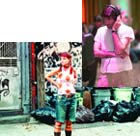NEW YORK - Okay, so that $6 million film you were set to work on has been downsized to a $150,000 digital movie. Under what conditions would you work for 100 bucks a day and still think that's a really good deal?
Just ask Peter Hedges, writer of What's Eating Gilbert Grape? and About A Boy, about his directorial debut - the United Artists release Pieces of April, starring Katie Holmes. "The movie was set for production and fell apart three times," says Hedges, philosophically. Finally, at the last moment, he and producer John Lyons took the project to New York-based InDigEnt (www.indigent.net), the digital production arm of the Independent Film Channel.

InDigGent co-founder Gary Winick (inset) says the decision to produce Pieces of April was a "no-brainer."
|
"John Lyons, who is a friend of mine, called me and said, 'I have a cast, financing fell through, would you consider making it?'" says former InDigEnt partner Alexis Alexanian, who now heads her own indie production company Elixir Films (www.elixirfilms.com).
"It was a no-brainer for us in terms of the script and the talent that Peter had put together, " says InDigEnt producer and co-founder Gary Winick.
What did take some adjustment was adapting to InDigEnt's streamlined approach to filmmaking. Alexanian says that the first thing they do when someone brings a project to InDigEnt is make them understand that "the whole production philosophy changes."
A NEW WAY OF WORKING
InDigEnt's pictures have short prep periods, and they are shot with miniDV cameras. Production departments are only one or two people deep. The approach is less about decorating and propping, she says, and more about finding what's organic to telling the story.
Hedges, it turned out, had no problem buying into this model. "I had written Pieces of April so that if no one would pay for it, I could pay for it myself."

For writer/director Peter Hedges, working on a tight budget suited him. "I come from the theater," he says.
|
Winick founded InDigEnt in 1999 with partners John Sloss and Alexis Alexanian in order to make powerfully voiced, independent digital features. Winick says he was inspired by Thomas Vinterberg's Dogme-style film Celebration, as well as the spirit of director/producer/actor John Cassavetes. Cassavetes, a pioneer of independent filmmaking, favored an improvisational, performance-driven approach to moviemaking. With the use of low-cost digital cameras and a lean production crew, Winick realized his idea could really work.
However the business model that makes his company click big time is Winick's insistence that everyone involved with a project owns a piece of the film. All the production personnel from director to actors to grips get paid points off the gross of whatever the film makes from the time it's sold.
Winick first approached his lawyer John Sloss, who liked the idea. They became partners and took the concept and sold it to Independent Film Channel president Jonathan Sehring.
"We wanted to do 10 films a year, but realistically we can do five," continues Winick. InDigEnt wanted the entire per-picture budget to be $100,000, but that wasn't feasable. Now they shoot it for $150,000 and after it's sold the buyer picks up the post production costs.
Pieces of April is InDigEnt's ninth production. Their resume includes Campbell Scott's Final, Ethan Hawke's Chelsea Walls, Bruce Wagner's Women in Film, Richard Linklater's Tape, Rodrigo Garcia's Ten Tiny Love Stories, Gary Winick's Tadpole, Rebecca Miller's Personal Velocity and Alan Taylor's Kill the Poor.
PIECES OF APRIL
For Hedges, directing his first feature for a very modest budget was like coming home. "I come from the theater where you make everything with no money and a lot of love."

Pieces of April was shot on miniDV with Sony PD-150s.
|
Hedges says he got most of his education as a director from watching Lasse Hallstrom direct Gilbert Grape. "I would look at dailies, and if the scene wasn't played exceptionally I thought it was useless. But Lasse would say, 'Well, no, there's plenty here.' So I learned that there are scenes that don't play perfectly when you shoot, but that are going to work when you cut everything together."
Hedges and cinematographer Tami Reiker (HBO's Carnivale) were handed two Sony PAL PD-150s and a lot of Sony tape to lens the October release, Pieces of April, which is her first digital feature.
"You use digital for what it's good for," she says. "You have small cameras that can get in tight places, they're cheap so you can shoot scenes with two cameras, and the tape, particularly with miniDV, is really cheap so you can shoot as much footage as you want.
Pieces of April only had 16 shooting days instead of the original 30 when the project was a big-budget film. "The movie is about running out of time, so the shorter production schedule fit the spirit of the film," Hedges says wryly.

Using a Film Composer, editor Mark Livolsi cut down 70 hours of tape to make this 80-minute feature.
|
Conceptualizing the look for digital video, Reiker worked closely with production designer Rick Butler and costume designer Laura Bauer. "One of the few tools you have with DV is the color palette. You know you can't shoot in bright sun and that there are certain colors that look bad," says Reiker.
"We picked locations that worked," she continues. "April's apartment had huge windows that gave a lot of available light. We painted the walls dark colors so they would absorb the light and make the image feel richer." And for lighting gear, she says, it was mostly Chinese lanterns, KinoFlos and white cards.
"With the PD-150s, the focus is very tricky," cautions Reiker. "To judge focus you have to use a 13-inch monitor," she insists. "We had an assistant glued to the monitor all the time to check focus and contrast."
THE POST
Reiker notes that she spent more time in post production on Pieces of April than all of her movies combined. First she spent a week at The Tape House in NYC - now doing business as Post Works (www. pwny.com) - color correcting the D-5 master, with colorist Joe Gawler, for the Sundance screening.
After the movie was sold to United Artists, she spent another week color correcting the picture for a tape-to-film transfer at Moving Images (www.mipost.com) in NYC with colorist Milan Boncich. He employed the Pandora Pogle.
Zurich-based Swiss Effects (www.swisseffects.ch) won the opportunity to do the tape-to-film transfer. Then that negative went to Michael Hatzer at Color by Deluxe in Hollywood (www.bydeluxe.com), who color timed the internegatives and prints.
"It was time consuming," recalls Reiker. All the shots had to be timed separately. There were also scenes that had moier patterns that were sent to The Mill (www.mill.uk.co) in NYC and corrected frame by frame within Flame.
However, in spite of all the hassle, ultimately the beauty of this system, says Reiker, is that the films get made, get out there, and everyone gets big checks on the back end.
Editor Mark Livolsi (Vanilla Sky, Almost Famous) says Hedges and Reiker handed him around 70 hours of footage to cut into the 80-minute feature.
"The film was tight," says Livolsi. It had a strong narrative drive and blending the three interconnecting stories - getting the turkey made, the family in the car and April's boy friend's mysterious meeting - was a good challenge.
Hedges says that, with Livolsi, he succeeded in finding an editor that had worked on films that were a like-minded balance between comedy and drama, and that he could pleasantly spend copious amounts of time with.
Livosi was cutting scenes almost as soon as they were shot, no developing required. "We slammed right away," he says, from the moment his assistant digitized the miniDV tapes into the InDigEnt-owned Avid Film Composer.
Hedges was in the edit room with Livolsi the day after shooting wrapped. Often Hedges would shoot multiple takes without cutting the camera, sometimes repeating individual line readings, creating takes within takes. "Joe Hutshing [editor, Vanilla Sky, Almost Famous] taught me a good Avid trick," says Livolsi. "Mark every line of dialogue so I can punch straight to it."
Stylistically they took a minimalist approach, making standard story driven cuts, no dissolves, no flashy two-frame edits. "I told Mark that I wanted it to feel like life," recalls Hedges. "This would be a story about people told as humanly as possible."
"We didn't talk about it that much, we just did it," says Livolsi. "We altered some sequences, changed the order of some things," says Hedges, but most of the edit was in the script, except for one scene in the beginning that Hedges shot improv. "We banged out a first cut about a month after shooting wrapped," says Livolsi proudly.
They did their online editing at The Tape House. On Pieces of April, they did an online PAL edit on the Henry Infinity. They output to PAL D-1 and did tape-to-tape color correction on the Pandora Pogle. That master went into the Quantel iQ where high-resolution titles were added, field merging applied and then finally upconverted to 1080i D-5. An HDCAM dub was made and sent to the Sundance Film Festival.
SAVING AND SUCCESS
Winick can be legitimately proud of what InDigEnt has accomplished. Their first five films sold to Lions Gate. Winick's Tadpole got picked up by Miramax, and Rebecca Miller's Personal Velocity was also acquired by United Artists. Alan Taylor's Kill the Poor just screened at the Tribeca Film Festival and IFC has authorized InDigEnt to make four more films. InDigEnt's Web site lists Gregory Harrison's November and Mark Christopher's Pizza as currently in production.
According to The Numbers Web site (www.the-numbers.com), InDigEnt's films have collectively earned over $4 million in box office grosses alone. Winick hopes that Pieces of April will be the big crossover picture that gets big box office.
The InDigEnt production pipeline is constantly changing. Pizza is being shot with Panasonic 24p DV AG-DVX 100 cameras. InDigEnt producer Jake Abraham is in Los Angeles in preproduction on InDigEnt's twelfth movie, a Wim Wenders film with the working title of Angst and Alienation in America. This co-production is being shot the with the PAL version of the Panasonic 24p DV AG-DVX 100 so Wenders can edit in Berlin on a European system.
However, logically one still wonders why stick with miniDV when you could still economically shoot with Digi Beta or even HD.
"It's not just a cost thing," says Abraham emphatically. "The day an HD camera fits in my palm is the day [Elixir] will be there. There is an intimacy in that hand-held approach that you can't get with even a shoulder mounted Digi Beta camera."
"Pieces of April is a great case study on how you can re-conceive the method of making a film," says Alexanian.
The InDigEnt system of filmmaking, she explains, is not about cutting budget or axing scenes. More importantly it proves that if the material is inspiring you can get the people to rally around your project and get the film made.